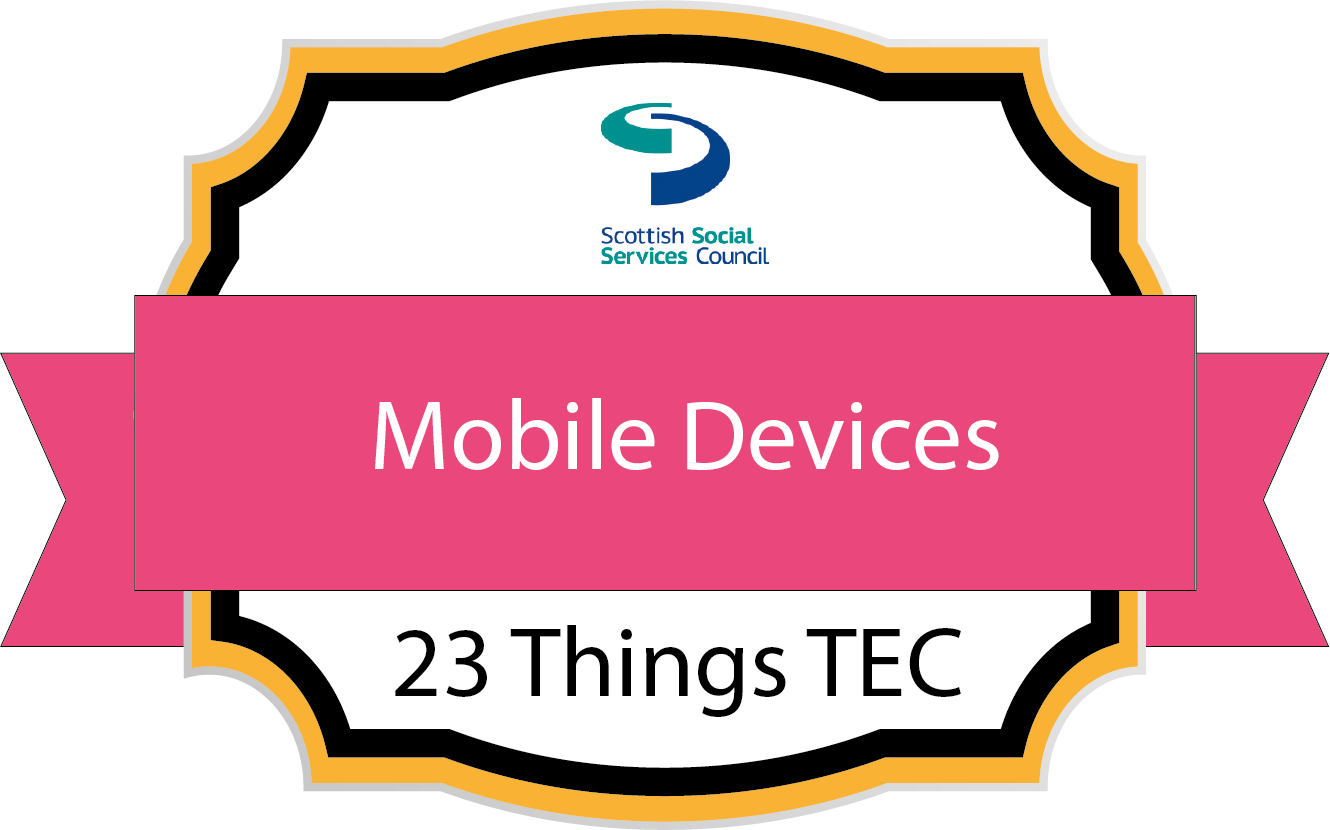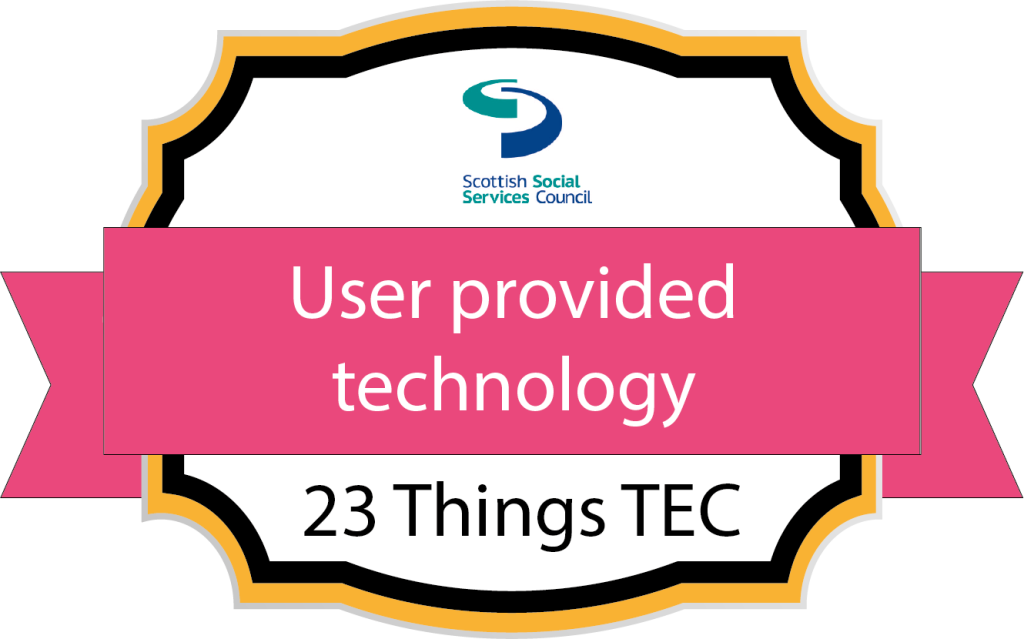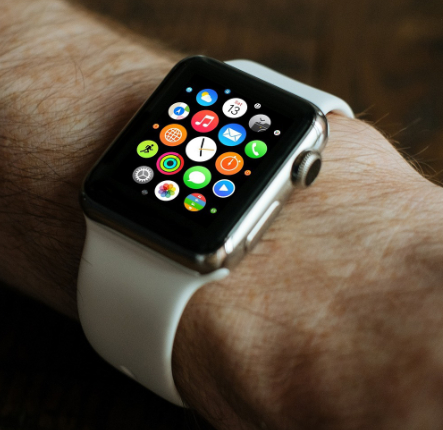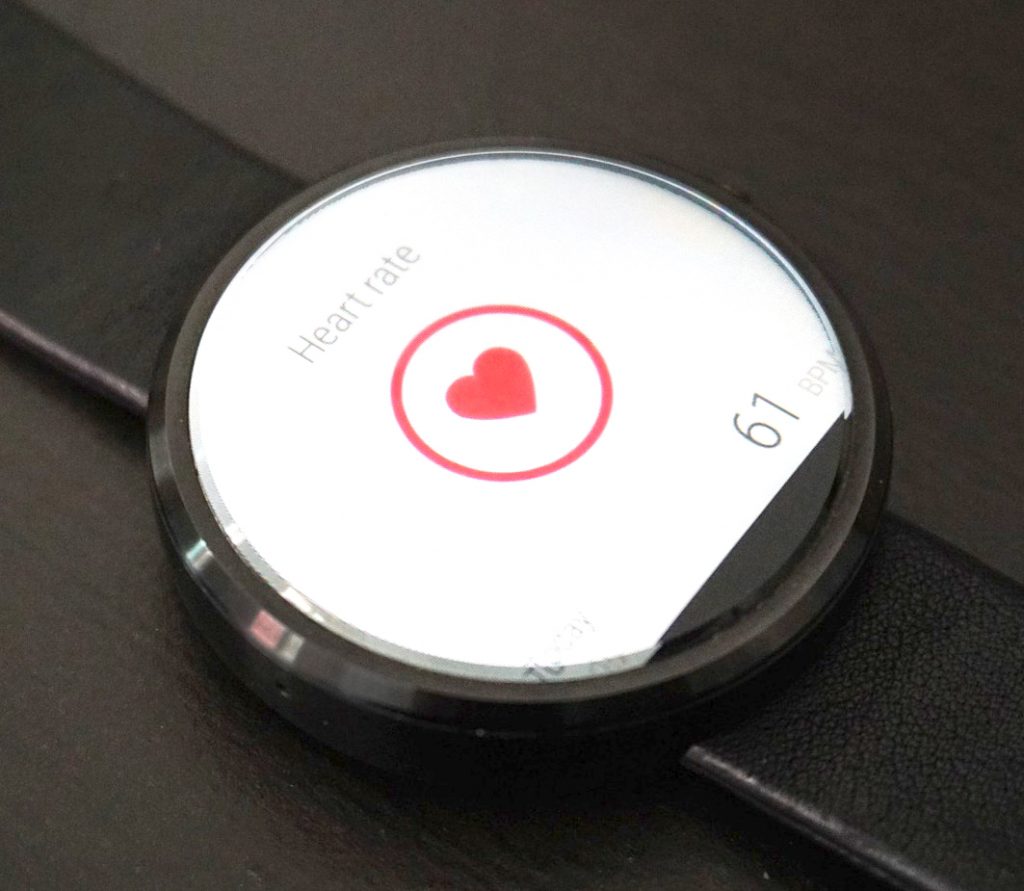Introduction
In this section, we will explore how you do not always need to use expensive, specialised equipment to provide technology enabled care to support people. The devices that are included are all readily available for people to buy in high street stores, supermarkets and online without needing a specialist supplier or assessment. This generally makes them less expensive than specialised equipment and means that people can start to get the benefits of the technology sooner than waiting for specialised suppliers.
MyLearning badge information
MyLearning Badge: SSSC 23 Things TEC – Thing 10: Mobile Devices.

Counts towards the ‘User Provided Technology‘ milestone badge.

What are mobile devices?
The Oxford Advanced Learner’s Dictionary defines a mobile device as ‘any small computing device, such as a smartphone or tablet’ (https://www.oxfordlearnersdictionaries.com/definition/english/mobile-device). This also includes ‘wearables’ such as smart watches. The following are examples of mobile devices.
Smartphone

A smartphone is a mobile phone that acts as a small computer. It can connect to the internet to enable you to access and interact with web pages. You can also download apps to enable you to do many different things from personal banking, listening to music, watching videos etc. Although it is called a phone, it may be helpful to think of this as a small computer that happens to enable you to make phone calls.
Possibly the most well-known smartphones are Apple’s iPhones which were first introduced in 2007. Apple has continued to develop these and now have several models available. Apple phones use an operating system call iOS that is exclusive to Apple products. There are many other models of smartphone available from other manufacturers like Samsung and Sony. Most of these other models of smartphone use an operating system called ‘Android’.
It is important to be aware that you usually also have to pay to use a smartphone to make calls, send text messages or access things online. These are usually monthly charges to access a company’s network and often include some calls and texts as part of the contract. Most contracts also include ‘data allowances’. Every time a smartphone connects to the internet there is a transfer of data between the phone and the network. Unless you are connected to a wifi network, like your own home network, your phone will use some of your data allowance to connect to the phone company’s network.
Tablet

A tablet is like a larger version of a smartphone, usually with the telephone call function removed. Like smartphones, you can download and use apps or use it online.
The bigger screen makes this easier to use for anything visual including reading, video calling and watching videos. This may make it more suitable for people with eyesight issues.
As a tablet is larger than a smartphone, it is probably going to be too big for most pockets. However the accessibility features and portability mean that this can be a good choice for people being supported in residential care and care at home services, where it may not be practical to use laptops or static PCs.
Examples of tablets are Apple’s iPad and Samsung’s Galaxy Tab A7 Lite. Like smartphones, you will need to connect a tablet to a network if you wish to access anything online. Usually, this would be through the broadband provider in your home or work, however some tablets also enable you to connect to phone networks using a SIM card like your smartphone.
Wearables

As the name suggests, wearables are devices that you wear that can be connected to other devices like smartphones or can connect online to send and receive information. The most common wearables are smart watches and activity/health trackers like ‘Fitbit’.
Smart watches often receive the same information as your smartphone such as text messages. Depending upon the model, they may also enable you to control music stored on your smartphone. Some smartphones can also be used to monitor health information such as heart rate, set reminders to take medication or drinks and even summon help if you fall. This may make them very useful for vulnerable people as an additional way of getting support.
Like other mobile devices, there may be a charge to connect and use smart watches.
Activity and health monitors like Fitbits usually focus on relaying information about your health and wellbeing to online services, who store this securely. This enables you to track changes over time to show any improvements or issues. Many people use these for motivation to make changes to their lifestyles such as taking more exercise.
Learning Activity 1
Most people in Scotland now have access to at least one mobile device, so if you do use mobile devices, please make a list of these and make a note of how the device has an impact on your daily living eg. being able to keep in contact with friends and family.
If you are working, please consider how mobile devices enhance, or could enhance, the lives of people you support. Make a note of this to attach to your application for the open badge relating to this ‘thing’.
The advantages of using mobile devices in your work

There are also advantages for you and your organisation when using mobile devices. For example, tablets can be shared more quickly and easily between people in residential care as they are so portable. If can be very useful if it is not feasible or affordable to give every resident their own device. Mobile devices are also easier to store as they tend to be smaller than laptops or PCs.
Many organisations also use mobile devices to support their workers. For example, if you work for a care at home service, your employer may provide you with a ‘work’ phone to enable them to keep in contact and send you updates. Many organisations also use digital recording to keep the information about people who use services like contact sheets and care plans up to date. This has led to the increased use of tablets in work settings to enable workers to add information.
The advantages of using mobile devices for people using services
Mobile devices can be used in many ways to promote the health, wellbeing and independence of people using services. For example, people living with diabetes can wear monitors on their skin that link to their smartphones to show their bold/glucose levels without having to prick their fingers. Not only is this less uncomfortable but it can enable real time monitoring and alert the person if their levels dip.
Another advantage of using mobile devices to support people is that the devices enable them to communicate remotely with other people from a location that suits them, usually the person’s home. This includes, keeping in contact with people who are significant to them like family and friends, attending medical appointments, doing shopping and being able to maintain control of their finances using banking apps.
Many mobile devices also enable people with additional needs to communicate more easily. Some (like Apple products) have accessibility features pre-installed on them while you may need to download apps on others to get these features. For people who have visual impairments, mobile devices can automatically convert written text to sound that enables them to read out texts and emails, while people with hearing impairments can use the features that convert speech into text to see what someone is saying, like the subtitles that can be shown on TV screens. However, you need to remember that these ‘closed captions’ are generated by the mobile device so may not always be accurate depending upon things like volume or an accent it cannot understand.

Wearables like smart watches can help to support the health and wellbeing of people. This can range from simply providing reminders to take fluids or medication to detecting when a person has fallen and alerting carers or support services. These can be really useful for enabling people to stay in their own homes but you must remember that these are to enhance and not replace the care and support that someone requires.
Things to consider when using mobile devices
While there are many advantages of using mobile devices, there are also things that you need to consider, particularly when people are sharing devices. Firstly, because these devices are more portable, there is more risk of them getting lost or stolen. Therefore, it is very important that you keep them as secure as possible by having strong password access or using a fingerprint reader or facial recognition if your device has this. Sometimes devices will be shared perhaps between residents in a care home. If this happens with your device, it is very important that you do not store and confidential or sensitive information on that device.

You may have heard that cyber criminals are constantly trying to get around the security in place for mobile devices and look for vulnerabilities in phone’s operating systems. When one of these vulnerabilities is identified the phone companies work as quickly as they can to address this. This is why you will regularly get messages telling you about updates to your phone’s software. It is really import that you update your phone as soon as you can when you receive one of these notices. Also, as device models get older, the companies may decide that it is not cost-effective or possible to maintain the security of these models. If you use a device that no longer gets security updates, you will be at increasing risk of someone being able to hack into the device and access your data and information. So it is a very good idea to update to a newer model if your phone producer tells you your phone or tablet is not going to get further security updates.
Always make sure that you know who is responsible for keeping your devices updated and make sure that you let them know if you find they have not been. Remember we all have a responsibility to keep digital devices secure, this is not just something that an IT department (if you have one) should do.
The COVID pandemic that started in 2020 led to more people using services using mobile devices to keep in touch with friends and family. In residential care settings, these devices were often shared. This highlighted how important it is that you have and follow strong infection prevention and control policies, including cleaning the devices after they have been used and before being given to someone else. Also most mobile devices now have touch screens so it is important to make sure that oil and grease from fingers does not build up on a screen as this could prevent the device from working properly.
Learning Activity 2
Think about the things to consider above and create a guide for your colleagues to follow when using mobile devices to support people using services. You may want to include more than is mentioned above to cover specific requirements for your service. Make a note of your guide and attach it to your application for this open badge.
